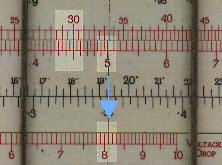1. This rule was made in Australia by W&G, a wholly owned
subsidiary of White and Gillespie.W&G was formed during the 1930s to make gramophone
records.In the second world war the company started making slide rules. When slide rule
production ceased the company was sold and still continue to make drawing instruments. The
original parent company, formed in 1910, still exists and continues to supply the printing
trade.
2. The front of the rule is fairly standard though the naming of the scales is not
completely conventional. The CI scale is referred as the reciprocal scale, the two log-log
scales are both referred to simply as LL and the K scale is referred to Cu.
3. The trig scales on the back are far from conventional. For sine there are two adjoining
scales; one has values of the angle from 0 to 90° in equal divisions and the equivalent
value of sine. For tangents there are also two adjoining scales; in this case the
angle goes from 0 to 45°, also in equal divisions, and the equivalent value of tan.
The advantage of this is greater accuracy for some ranges of angles; the disadvantage
(which is probably enough to explain why this layout is rare) is that the value then has
to be transferred to one of the other scale for calculations.
4. The rule also has scales for electrical calculations (see below). Unlike many other
electrical rules these scales are on the body of the rule in the well of the stock.
5. To compensate for differences of temperature there is a short scale of temperature in
Fahrenheit.
6. The single line cursor has a very fine, yet legible, hair line. Unfortunately it is on
the outside face of the fairly thick glass cursor which gives rise to parallax problems
when using it.
7. The rule is made of xylonite on wood.
8. A summary manual is available at:
http://sliderule.ozmanor.com/man/man-download.htmlhttp://sliderule.ozmanor.com/man/man-download.html
My thanks to Cyril Catt for information on W&G.

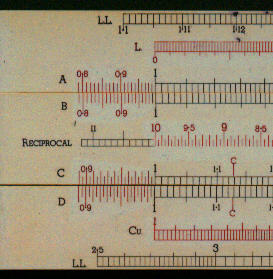
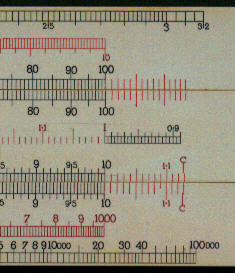

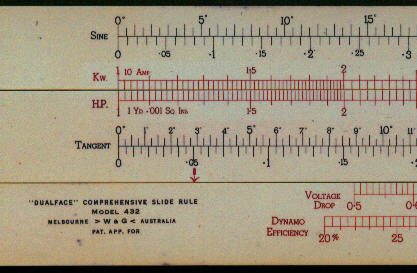
Detail - back right
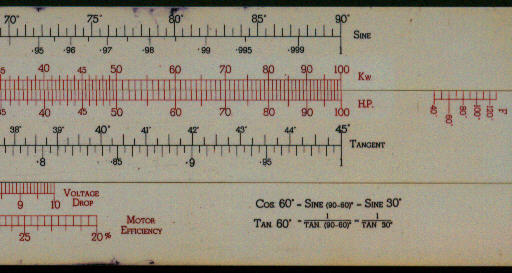
Sine, Kw=A [HP=B, Tangent] Voltage, Efficiency
The slide also has a short scale for temperature.
Summary of Instructions
This rule has special scales in two areas, trigonometry and electricity.
In the case of trigonometry scales, as noted above, the scales are linear for angles.
In the case of electricity there are special scales and gauges marks for efficiencies and voltage loss. The rule has a gauge mark at 746 on the Kw scale and HP scale, for w per HP. It also has a special mark (a small red vertical arrow) for calculation of efficiencies. It is also set up for voltage loss of copper cables using imperial units. It should be noted that on the scale marked Kw the value marked 10, relative to the 746 gauge mark, is actually 1 Kw. This make some calculations, and also following the instructions a bit confusing at times.
There is a further small scale which allows the variation of resistance with
temperature to be calculated. It assumes that the nominal resistance is measured at
60° F.
The image below shows the value of sine 85°. As can be seen the scales are easier to read than on a normal scale rule however this advantages is lost once the value is transferred to the C or D scale for a calculation. There is also an additional risk of error from having to note down and copy the value.
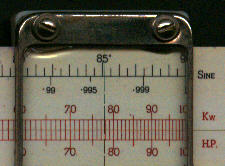
Example
What is the efficiency of a dynamo giving 13.8 kilowatts with an input of 23 horse-power.
Set the horse power (23.0) against the kilowatts (13.8). Note the need to
"shift" the scale to take account of the units and location of the gauge mark.
Against the special mark read the efficiency of 80.5%.
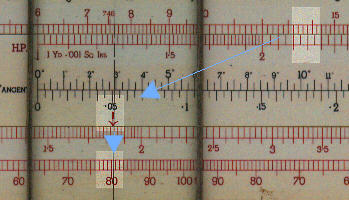
Example
What is the efficiency a motor which, with 19 kilowatts, delivers 19.9 horsepower.
Set the kilowatts, 19, against the horse power, 19.9.
Against the special mark read the efficiency 78%.
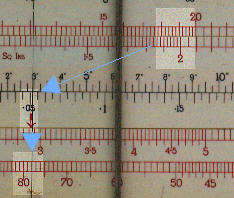
Example
The resistance of a copper conductor at 60° is 11 ohms. What is its resistance at 80°.
Set the line for 60° against 11 on the Kw scale and read the value, 11.5 ohms, against
the 80° mark. Note that even with the scanner the potential problem of parallax error
manifests itself.

The voltage drop scale is constructed so that the drop is given for a copper conductor having a resistance of 0.0240079 ohms for a length of 1000 yards and across sectional area of 1 square inch at a temperature of 60° F. This corresponds to the recognised standard at the time. The current scale is equivalent to currents from 10 to 1000 amps, the left had being marked 10 amps. The length and area scale are similarly correspond to lengths of 1 to 100 yards and areas from 0.001 to 0.1 square inches.
Example
What is the voltage drop when 30 amps flow along a conductor 50 yards in length having a
cross- sectional area of 0.0045 square inches.
Set the hair line to 3 amps (= 30 on scale) and move the .0045 (=4.5) sq. ins. mark on the
slide against it. Read the voltage drop, 8.1 volts, opposite the 50 yards mark.
